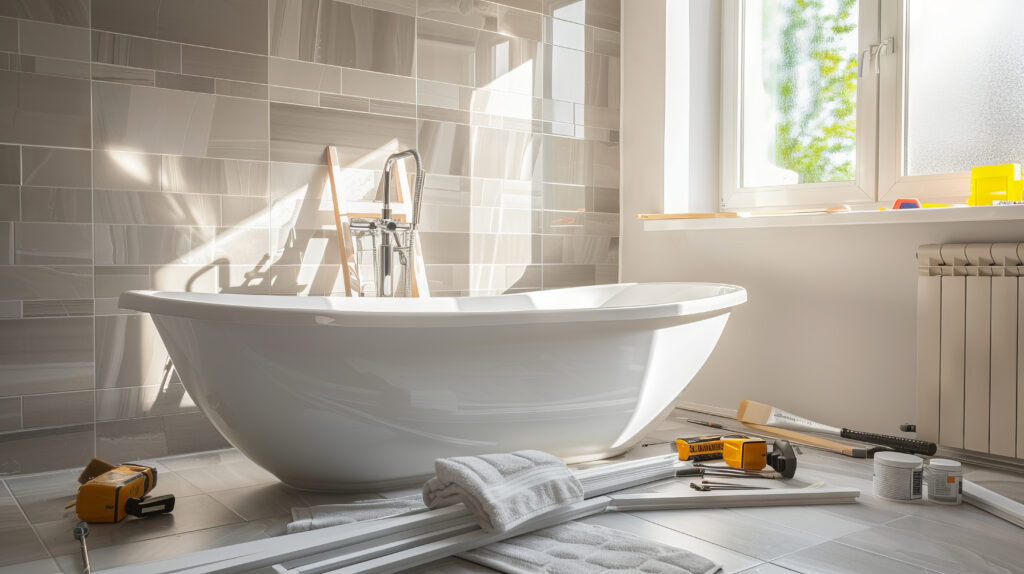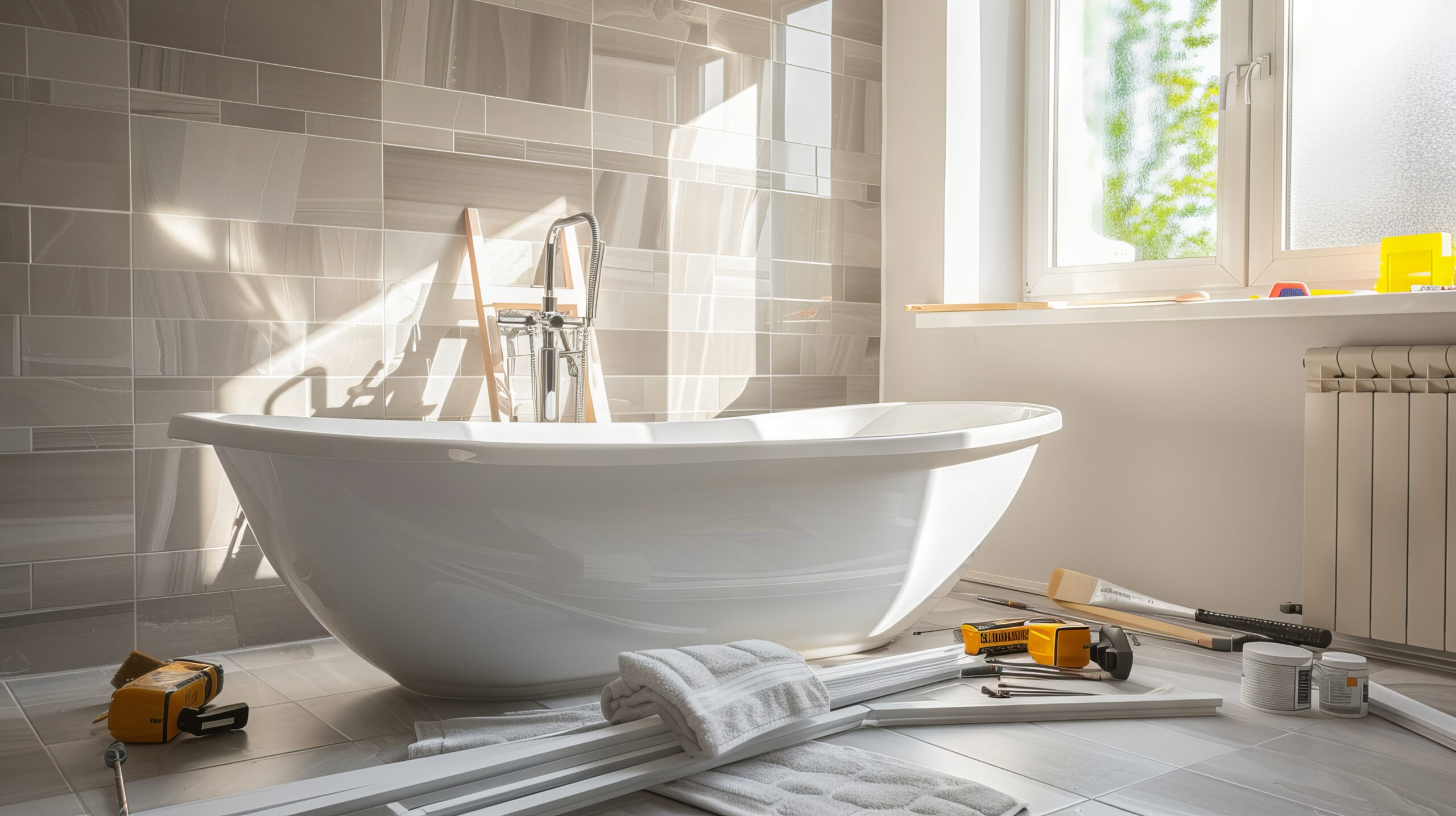Last month, I watched my neighbor Kate sink onto her couch in despair.
She’d just spent a small fortune on her bathroom renovation, and something already wasn’t right.
“The marble looks amazing,” she sighed, “but the shower temperature fluctuates wildly whenever someone uses the kitchen sink, and there’s nowhere to put anything.”
Classic case of choosing pretty over practical.
I’ve overseen dozens of bathroom renovations over the years, both personally and professionally, and I’ve developed a theory: the best bathroom upgrades aren’t the ones that photograph well for Instagram.

Modern Bathroom Renovation With Luxurious Bathtub
They’re the ones that make you silently grateful every single morning when you’re barely awake, stumbling through your routine.
The Hidden Heroes: Investments Nobody Sees (But Everyone Feels)
There’s something deeply unsexy about spending money on things hidden inside walls. Try posting a photo of your waterproofing membrane on social media—I guarantee zero likes. Yet these invisible elements determine whether your beautiful bathroom remains beautiful for five years or fifteen.
Real Talk About Radiant Floors
The first time I experienced heated bathroom floors wasn’t in a luxury spa—it was in my friend’s modest ranch house in Minnesota. I stepped out of the shower onto warm tile and audibly gasped. “That reaction? That’s why I ate ramen for three months to afford it,” she laughed.
Radiant heating doesn’t just prevent the toe-curling shock of cold tile; it fundamentally changes how the room feels. Unlike forced air that creates pockets of warmth, radiant heat rises evenly from the floor, enveloping you in consistent comfort. My clients who install it universally say the same thing: “I had no idea what I was missing.”
The surprising truth? While installation costs aren’t insignificant, running expenses are remarkably reasonable. My own 85-square-foot bathroom adds roughly $12 to my monthly utility bill when running constantly during winter months—less than half what my previous space heater consumed while providing measurably inferior comfort.
Waterproofing That’s Actually Waterproof
Nothing humbles a homeowner quite like water damage. I’ve torn open walls in seemingly pristine bathrooms to find hidden horror shows of mold and rot. The culprit? Corners cut on waterproofing.
Standard contractor-grade waterproofing often amounts to little more than hope wrapped in plastic sheeting. True waterproofing systems like Schluter or Wedi effectively create a bathtub within your walls—complete, seamless barriers that contain water where it belongs.
When a client balks at the additional cost (typically adding $800-1200 to a standard shower), I show them photos from my disaster portfolio. Those images of damaged subfloors and moldy studs usually end the conversation immediately. Nobody ever regrets proper waterproofing, but plenty regret skipping it.
Morning-Making Features: The Daily Difference
Some bathroom features don’t just enhance your home—they improve your actual life, day after day, in small but meaningful ways.
Temperature Certainty: The End of Shower Screams
Remember those childhood moments of terror when someone flushed a toilet during your shower? The modern solution isn’t just better plumbing—it’s thermostatic valves that actually maintain your preferred water temperature regardless of what happens elsewhere in your home.
Unlike standard pressure-balancing valves (which prevent scalding but allow temperature drift), thermostatic systems maintain the exact temperature you select. Once you experience showering without constant minor adjustments, returning to a standard valve feels distinctly uncivilized.
Storage That Actually Stores Your Stuff
Generic bathroom storage is designed for generic people who apparently own three washcloths and one bottle of shampoo. Real humans need solutions designed around actual morning routines.
The most functional bathrooms I’ve designed include vanities with dedicated spaces for hot tools (with heat-resistant surfaces), medicine organization, and outlets hidden inside drawers to eliminate counter clutter. When everything has a specific home, mornings become measurably less chaotic.
The Wellness Upgrade: Ventilation Nobody Thinks About
If you’ve ever stepped into a bathroom and immediately thought “something feels off,” chances are you were sensing poor air quality. Standard builder-grade fans typically move about as much air as an asthmatic gerbil.
A properly sized, well-designed ventilation system does more than prevent foggy mirrors—it creates a bathroom that feels fresh rather than damp and stale. It prevents mold growth in hidden areas and protects your investment in drywall, paint, and woodwork.
The whisper-quiet operation of premium fans means you’ll actually use them consistently, unlike the jet-engine roar of budget models that everyone turns off after thirty seconds. Humidity-sensing models that run automatically have transformed bathrooms in even the most technology-resistant households I work with.
True bathroom luxury isn’t about gold fixtures or rare marble. It’s about creating a space that silently, efficiently supports your daily life—making that bleary-eyed 6 AM routine just a little more pleasant, one warm floor and perfect shower at a time.

